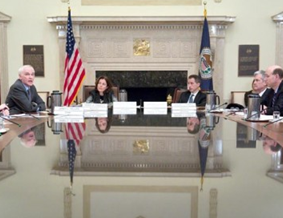The Fed released the minutes from the October policy meeting yesterday, and a majority of the members of the Fed Open Market Committee (FOMC) were in favor of a rate hike at the next policy meeting on December 15-16.
Most participants anticipated that, based on their assessment of the current economic situation and their outlook for economic activity, the labor market, and inflation, these conditions could well be met by the time of the next meeting.
Even before the minutes were released, Fed officials were telegraphing their intentions. Four regional Fed presidents made hawkish comments Wednesday morning, reassuring investors that they believe the US economy is on solid footing, and that they intend to raise interest rates soon.
Three of them – New York Fed President William Dudley, Cleveland Fed President Loretta Mester and Atlanta Fed President Dennis Lockhart – appeared at a panel at the Clearing House annual conference in New York and openly backed an interest-rate hike soon, while Richmond Fed President Jeffrey Lacker did the same in an interview yesterday on CNBC.
As myself and others have suggested in recent days, the Fed was very impressed by the stronger than expected October jobs report that sent the unemployment rate down to 5.0% and the much higher than expected 271,000 net new jobs created last month.
A minority of doves (don’t raise rates) on the policy Committee thought the new language signaled too strongly the expectation that the Fed Funds rate would be increased at the December meeting. Yet they were out-numbered by the hawks (raise rates soon).
“We think, though, that all but the most ardent doves will have been swayed, at least in part, by the across-the-board strength in the October employment report,” said Ian Shepherdson, chief economist at Pantheon Macroeconomics.
Supporters of a December move presented several reasons to hike. They argued that a further delay in raising rates would signal a lack of confidence in the economy and would only make financial markets more anxious about the perceived importance of a first move.
Those in favor of tightening in December also argued that hiking soon would make it more likely that the policy trajectory – that is subsequent rate increases – after liftoff would be “shallow” rather than steep.
Officials also explained why they removed a sentence in the previous policy statement that raised concerns about global and financial market developments in the late summer. In their discussion, Fed officials noted that the summer volatility in global markets had abated since September. “The U.S. financial system appeared to have weathered the turbulence in global financial markets without any sign of systemic stress,” the minutes said.
Despite the slowdown in third quarter GDP, officials said there is “solid underlying momentum” in business and consumer demand. I say that remains to be seen, since I’ve read several recent predictions that the upcoming holiday shopping season will be disappointing.
In any event, it now appears very likely that the Fed will raise the Fed Funds rate, probably by one-quarter point, at the end of the December 15-16 FOMC policy meeting. At this point, I would say there will have to be some negative surprise for lift-off not to occur next month.
The Fed Funds futures market implied a 71.7% probability of a rate hike next month as of this morning. I expect that number to go higher as we approach the next FOMC meeting, absent any negative surprises.
It remains to be seen how the stock and bond markets will react to the first rate hike. It is clear that QE1, QE2, QE3 and zero-bound interest rates drove the equity and bond markets significantly higher since 2009. So, I have to assume that the upcoming period of higher interest rates and no bond buying by the Fed will weigh on both equities and bonds.
How much so? No one knows. There is still time to move into time-tested actively managed strategies that are designed to reduce risk and, in some cases, move to cash if market conditions warrant.
Reducing risks has been my main theme since back in March and April when I advised reducing long-only equity exposure. It continues to be my advice today. But only you can take action to protect yourself – I can’t do it for you – call 800-348-3601.


